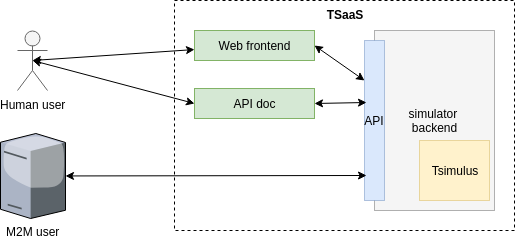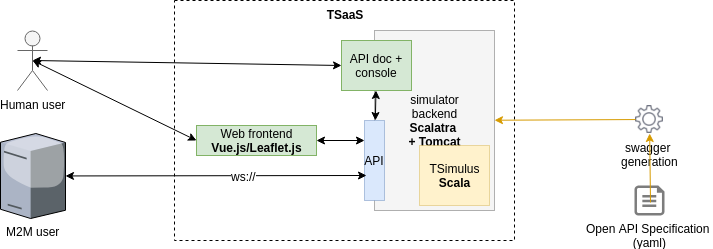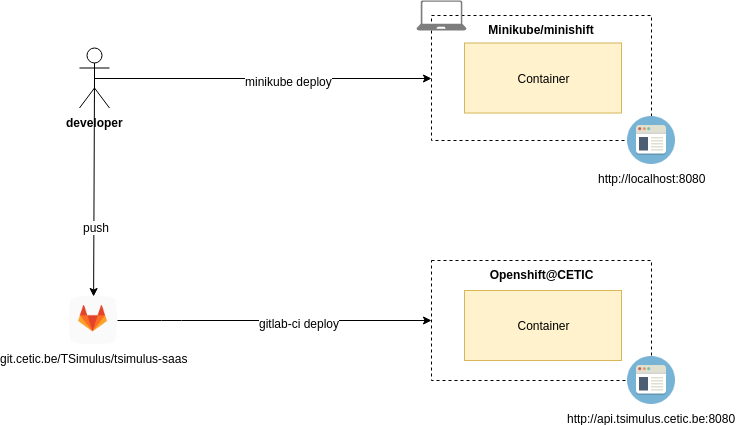This project contains the high level documentation for the TSimulus SaaS project. The aim of this work is to provide a self service that showcases TSimulus capabilities.
The project aims at building a REST API in front of the TSimulus framework, and a set of configurable websocket routes to consume the Tsimulus stream.
The project is strucured as a sbt multiproject, each part are runnable as standalone and the top level project coordinates a complete deployment and coordination of each parts. In the following it is assumed that sbt is installed in your system.
The backend implements the core logic for the stream handling. It includes
- wrapping the TSimulus for generating streams,
- exposing a configuration and control REST API,
- exposing websocket routes fed by outputs of the generator
- handling the timing of data injection into the websockets.
- processing templates for custom rendering of the generated data.
Install sbt on your machine.
OR
Install Vagrant and Virtualbox
Clone this repository
git clone git@git.cetic.be:TSimulus/tsimulus-saas.git
In order to run the backend server, log into the project directory and run
sbt runor from the root project, run
sbt backend/run0.2.1. Local development with Vagrant
Launch the VM and ssh into it: (Vagrant will install sbt and docker on the VM)
vagrant up
vagrant sshGo into your shared /vagrant folder.
Then, run each line in a new terminal.
sbt backend/run
The /vagrant folder in the VM is shared with the folder where the Vagrantfile is on the host computer.
0.3. Local development environment with Minikube
- a virtualisation solution (for example VirtualBox or KVM)
- Kubectl, the Kubernetes CLI
- Minikube, a local Kubernetes cluster
- the Helm client
Start Minikube:
minikube start
To get the Kubernetes dashboard, type:
minikube dashboardLaunch the Helm script, this will deploy all the TSimulus-saas services (TSimulus microservice and Swagger UI) on the Minikube cluster (and may take some time).
# init helm
helm init --history-max 200 --upgrade
# add helm repos
helm repo add cetic https://cetic.github.io/helm-charts/
helm repo update
# install/upgrade tsaas
helm upgrade --install tsaas cetic/tsaas
# install/upgrade swaggerui
helm upgrade --install swaggerui cetic/swaggerui -f ./helm/swaggerui/values.yaml --set swaggerui.server.url=$(minikube service tsaas --url)
To access the different services, type
minikube service list
You should now be able to access to the swaggerui:
To delete the tsaas stack, type:
helm delete --purge tsaas
helm delete --purge swaggerui
The websockets are exposed at the following URL:
ws://your.domain.be/socket/<UUID>
where is a UUID.
The websocket handlers are built on the fly, when one of the two following condition is met:
- A user connects to a websocket route: the server will create a stream with the uuid provided in the socket route.
- A user posts a configuration:
- Letting the server define a socket id
- choosing socket id. In this case, successive posts will update the configuration.
The configuration routes provide a CRUD api to manage the stream configurations, the control API exposes a set of action to manage the stream consuption. These APIs are documented in the next subproject, exposing a complete Open Api Specification and an API explorer.
A stream configuration consists in
- A Tsimulus configuration
- A consumption speed
- A template
- A type variable, set to "tsimulus" for tsimulus streams.
The stream configuation is to be sent in a json object to the stream configuration api:
{
"configuration": ...,
"template": ...,
"speed": ...,
"type": "tsimulus"
}Please refer to the official Tsimulus documentation for proper formatting.
The template object includes has the schema:
{
"template": "string",
"timeVariable": "string",
"nameVariable": "string",
"valueVariavle": "string"
}The template string is processed by the Apache FreeMarker engine. We refer the user to the official documentation.
We additionally provide 3 custom functions in the template :
- b64("little"|"big", number | list of numbers): This function converts each numbers to 32 bits floats and converts the resulting byte array to base 64, using little or big endianness.
- replicate(n, x): converts the value to a list of size n with the same value x.
- noise(?std, x): adds random noise to x. For numeric values of x, gaussian noise is added, with a null expectation value and a standrad deviation given by std.
The timeVariable, nameVariable and valueVariable variables represents respectively the names of the time, name and value variables in the template.
The speed parameter can be a string or a number. Each elements of a tsimulus stream comes with a timestamp and a value. The stream can be consumed in three different ways:
- realtime: The value is pushed in the websocket when the present datetime given by the server corresponds to the generated timestamp.
- Speed factor: The present datetime is ignored, only the time interval for the next element is taken into consideration. In this mode, the first element of the stream is emitted when the stream is started. The next element is emitted after a delay given by
Delay = (t_1-t_0)/speed_factor
- Infinite speed: The stream is consumed at once.
The speed parameter should be configured as
{"speed": "realtime"}for the realtime mode,
{"speed": "number"}for the speed factor mode and
{"speed": "inf"}for the infinite speed mode.
This subproject exposes a Swagger UI is exposed . The UI documents and allows to test the Configuration and control API described in the previous section.
???
To be done
Definition of TSimulus from the documentation: https://tsimulus.readthedocs.io/en/latest/
TSimulus is a toolkit for generating random, yet realistic, time series. In this project, a time series is nothing but a orderly sequence of points in times, each of them being associated to at most a value. Time series are used in a wide variety of areas, including finance, weather forecasting, and signal processing.
While random-number generators can easily be used for producing sequences of unrelated (or, at least, hardly predictable) numbers, generating sequences of numbers that seem to respect some obvious patterns is also interesting in many circumstances, including the simulation of data acquisition in the aforementioned areas.
In order to make realistic time series, a convincing noise must generally be added to some specified patterns. In addition, the values of a time series may be related to those of an other time series.
The TSimulus project provides tools for specifying the shape of a time series (general patterns, cycles, importance of the added noise, etc.) and for converting this specification into time series values.
Diagram sources are "here":https://drive.google.com/file/d/1rnZyI9u_A6-WpI8hoYdyxOqa6jFwWeNK/view?usp=sharing (draw.io format)
- tsimulus-backend: this service uses the TSimulus library to generate timeseries.
- web frontend provides a web interface to query the service and display the results to humans.
- API serves the backend service to programmatic clients and the web frontend.
- api doc provides
- documentation for the API (endpoints, examples, errors, ...).
- a console to test the API.
- autogenerated API clients in various languages.
- Human user: uses the website to try the service, and views the api documentation.
- M2M user: external service has automated API usage.
- web frontend: Play Scala app to display the result.
- API doc: doc/console/clients website auto generated from Swagger file.
- TSimulus backend + API server: Akka actor + Akka cluster.
Developers use local Virtualbox+Vagrant virtual machine.
For now, the service is pushed to OpenShift with Gitlab CI.
If using git: simplified version of Git Flow with mostly only master, develop and feature branches.
- new work is done on feature branches: e.g. the branch
feature/ns4b4ckd00rwill contain new developments intended to improve the security of the service - once a feature is ready to be integrated in the
developmentenvironment, it is merged into thedevelopbranch. - each merge of features into
developbranch triggers:- build and publish artefacts.
- deployment to the
developmentenvironment: previous Docker containers are destroyed and recreated on OpenShift with the new version of the service contained in thedevelopbranch. - various tests
- once the new version has been successfully deployed to the
developmentenvironment and all tests are green, merge branchdevelopto branchmasterto trigger deployment toproductionenvironment (and run more tests)
- server provisioning (creation of VM's and software installation): Ansible
- local dev environment: Vagrant+Virtualbox using the Ansible provisioning script
- Old Sample for Gitlab CI orchestrates the workflow. See the "gitlab-ci" file: https://git.cetic.be/TSimulus/tsimulus-cluster/blob/develop/.gitlab-ci.yml
Using Swagger-UI docker image: https://hub.docker.com/r/swaggerapi/swagger-ui/
TBD
? unit testing ? API testing ? load testing ? ...
TSimulus SaaS is release under the Apache license (version 2).






